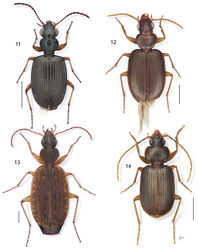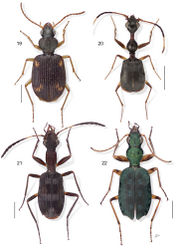Lachnophorini
| Notice: | This page is derived from the original publication listed below, whose author(s) should always be credited. Further contributors may edit and improve the content of this page and, consequently, need to be credited as well (see page history). Any assessment of factual correctness requires a careful review of the original article as well as of subsequent contributions.
If you are uncertain whether your planned contribution is correct or not, we suggest that you use the associated discussion page instead of editing the page directly. This page should be cited as follows (rationale):
Citation formats to copy and paste
BibTeX: @article{Erwin2014ZooKeys430, RIS/ Endnote: TY - JOUR Wikipedia/ Citizendium: <ref name="Erwin2014ZooKeys430">{{Citation See also the citation download page at the journal. |
Ordo: Coleoptera
Familia: Carabidae
Name
LeConte, 1853 – Wikispecies link – Pensoft Profile
- Lachnophorini LeConte, 1853: 370
- Anchonodérides Lacordaire, 1854: 373
- Eucaeri LeConte, 1861: 22
- Egini G. Horn, 1881: 152
Diagnosis
Body form ranges from Agonum-like in Anchonoderus Reiche adults (Fig. 52) to ant-like in those of Ega Laporte de Castelnau (Fig. 56), Selina Motschulsky (Fig. 20), and Stenocheila Laporte de Castelnau (Fig. 21). Mandibles are markedly falciform (subfalciform in Anchonoderus). Subgena with patch of setae ventrad the eye, or entire venter of head with sparse short vestiture (except in Amphithasus, Aporesthus, Diplacanthogaster, Guatemalteca, Homethes, Lachnaces, and Quammenis); antennomeres 2 and 3 fully setose (except in Aporesthus, Diplacanthogaster, Guatemalteca, Homethes, and Quammenis); apical palpomeres inflated or fusiform; apical labial palpomere with short setae (except in Anchonoderus, Aporesthus, Guatemalteca, Homethes, Peruphorticus, and Pseudophorticus); elytra obliquely truncate (and deeply sinuate in Aeolodermus, Quammenis, and Stenocheila); abdominal sterna with scattered setae (except in Aporesthus, Diplacanthogaster, and Quammenis); spermatheca bipartite, or derivable from a bipartite ground plan (cf. Liebherr 1988[1]), but not yet checked in several genera. We note that the mentum is toothed or not in adults of lachnophorine genera; we have not used that here, but LSZ will do so in an upcoming phylogenetic study of the tribe.
Notes
We have arrayed the lachnophorine genera in two subtribes based on vestiture and body form: Eucaerina LeConte contains Amphithasus, Aporesthus, Asklepia, Eucaerus, Guatemalteca, and Lachnaces, all of which have adults with little, or no general setation and except for Amphithasus are of planate body form; and Lachnophorina LeConte contains Anchonoderus, Calybe, Ega, Euphorticus, Lachnophorus, Pseudophorticus, Peruphorticus, and Selina, adults of which are richly invested with setae and/or pubescence and of a medium to markedly convex body form. Given that Selina is the only Eastern Hemisphere taxon in this group, its adult similarity to Ega adults may be convergence.
We note that Amphithasus is somewhat “forced” into the Eucaerina herein provisionally until such time that a major phylogenetic analysis can be undertaken either by a detailed morphological analysis, a molecular analysis, or desirably both. Attributes of the rarely collected adults of this genus are sufficiently distinctive that they may deserve a subtribe of their own (and that subtribe may also include three undescribed genera of which we have only six specimens and are reluctant to describe at present – one of these, with three species, has evolved somewhat parallel to the members of Rhadine LeConte, 1848, a platynine genus). In regard to Quammenis, we believe it to be closely associated with Diplacanthogaster Liebke, 1932 and Stenocheila Laporte de Castelnau, 1832 of South America; and if so, then both Homethes Newman, 1842 and Aeolodermus Andrewes, 1929 of the Old World need to be reconsidered because adults of Aeolodermus have much in common with adults of Quammenis. For the present, we treat these five genera as incertae sedis within the Lachnophorini.
References
Andrewes (1929)[2], Ball and Hilchie (1983)[3], Ball and Bousquet (2000)[4], Bousquet (2012)[5], Chaudoir (1872)[6], Darlington (1956)[7], Erwin (1991[8], 2000[9], 2004[10]), Erwin et al. (2012)[11], Liebke (1932[12], 1938[13]), Jeannel (1948)[14], Liebherr (1983[15], 1988[1], 1990[16]), Louwerens (1952)[17], Reichardt (1967[18], 1974[19]).
Key to the genera of the Lachnophorini
Taxon Treatment
- Erwin, T; Zamorano, L; 2014: A synopsis of the tribe Lachnophorini, with a new genus of Neotropical distribution and a revision of the Neotropical genus Asklepia Liebke, 1938 (Insecta, Coleoptera, Carabidae) ZooKeys, 430: 1-108. doi
Images
|
Other References
- ↑ 1.0 1.1 Liebherr J (1988) Redefinition of the Supertribe Odacanthitae, and revision of the West Indian Lachnophorini (Coleoptera: Carabidae). Quaestiones entomolgicae 24(1): 1–42.
- ↑ Andrewes H (1929) Papers on Oriental Carabidae. The Annals and Magazine of Natural History 10(4): 353–371. doi: 10.1080/00222932908673067
- ↑ Ball G, Hilchie G (1983) Cymindine Lebiini of authors: redefinition and reclassification of genera (Coleoptera: Carabidae). Quaestiones entomologicae 19: 93–216.
- ↑ Ball G, Bousquet Y (2000) Carabidae Latreille, 1810. In: Arnett R Thomas M (Eds) American beetles. Volume 1. Archostemata, Myxophaga, Adephaga, Polyphaga:Staphyliniformia. CRC Press, Boca Raton, Florida, 32–132.
- ↑ Bousquet Y (2012) Catalogue of Geadephaga (Coleoptera, Adephaga) of America, north of Mexico (in three parts). ZooKeys 245: 1–1722. doi: 10.3897/zookeys.245.3416
- ↑ Chaudoir M (1872) Observations sur quelques genres de Carabiques avec la description d’espèces nouvelles. Bulletin de la Société Impériale des naturalistes de Moscou 155: 382–420.
- ↑ Darlington P (1956) Australian carabid beetles III. Notes on the Agonini. Psyche 63(1): 1–10. doi: 10.1155/1956/57940
- ↑ Erwin T (1991) Natural history of the carabid beetles at the BIOLAT Rio Manu Biological Station, Pakitza, Perú. Revista Peruana de Entomología 33: 1–85.
- ↑ Erwin T (2000) A new genus and species of Lachnophorini and two new species of Lebiini from Costa Rica (Coleoptera: Carabidae). The Coleopterists Bulletin 54(3): 279–283. doi: 10.1649/0010-065X(2000)054[0279:ANGASO]2.0.CO;2
- ↑ Erwin T (2004) The Beetle Family Carabidae of Costa Rica and Panamá: Descriptions of four new genera and six new species with notes on their way of life (Insecta: Coleoptera). Zootaxa 537: 1–18.
- ↑ Erwin T, Micheli C, Hevel G (2012) The Beetle Family Carabidae of Guyane (French Guyana): The Tribes, Genera, and number of species known, with notes on their ways of life. (Insecta: Coleoptera: Adephaga). Le Coléoptériste 5: 1–88. [ACOREP, Paris]
- ↑ Liebke M (1932) Laufkäfer Studien X. Entomologische Anzeiger 12: 146–149, 159–162, 193–195.
- ↑ Liebke M (1938) Denkschrift über die Carabiden-Tribus Colliurini. Festschrift zum 60. Geburtstage von Profesor Dr. Embrik Strand 4: 37–141.
- ↑ Jeannel R (1948) Coléoptères carabiques de la région malgache (deuxième partie). Faune de l’Empire Française, 10: 373–765. [Office de la Recherche scientifique coloniale, Paris]
- ↑ Liebherr J (1983) Larval description of Calybe (Ega) sallei (Chevrolat) with preliminary assessment of lachnophorine affinities (Carabidae: Lachnophorini). The Coleopterists Bulletin 37(3): 254–260.
- ↑ Liebherr J (1990) A new Tribal placement for the Australasian Genera Homethes and Aeolodermus (Coleoptera: Carabidae: Odacanthini). Pan-Pacific Entomologist 66(4): 312–321.
- ↑ Louwerens C (1952) New Carabidae from the Malay Archipelago (Col.). Treubia, 21: 211–229.
- ↑ Reichardt H (1967) On Stenocheila Castelnau (Coleoptera: Carabidae). Papéis Avulsos de Zoología 21(25): 247–250.
- ↑ Reichardt H (1974) The systematic position of Asklepia Liebke, 1938, with a description of a new species (Coleoptera, Carabidae). The Coleopterists Bulletin 28(4): 177–179.








